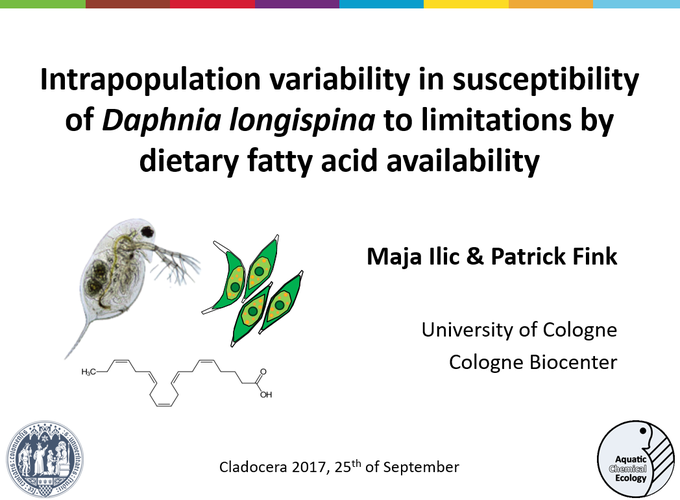Intrapopulation variability in susceptibility of Daphnia longispina to limitations by dietary fatty acid availability

Intrapopulation variability in susceptibility of Daphnia longispina to limitations by dietary fatty acid availability
Abstract
One of the factors that determine food quality of phytoplankton for herbivorous zooplankton (e.g. Daphnia) is the availability of polyunsaturated fatty acids (PUFAs). It has been shown that particular ω3- and ω6-PUFAs have a positive effect on the fitness of Daphnia. As Daphnia is not able to synthesize these PUFAs de novo, they are essential dietary components for daphnids. Essential PUFAs are thus a functional phytoplankton trait that affects the trophic transfer efficiency and dynamics between the primary producers and consumers. In turn, the susceptibility of consumers to become limited by the availability of essential PUFAs is a fitness-determining trait of Daphnia genotypes. The variability of this herbivore trait will thus affect the daphnids’ intrapopulation competition. To estimate the susceptibility of different Daphnia longispina clones from a natural population to limitations by dietary PUFA availability, we conducted standardized laboratory growth assays. D. longispina juveniles were fed with the green alga Scenedesmus obliquus, which lacks particular PUFAs like eicosapentaenoic acid (EPA, 20:5 ω3) and arachidonic acid (ARA, 20:4 ω6). We used a liposome supplementation technique to enrich S. obliquus with EPA, ARA and α-linoleic acid (ALA, 18:3 ω3). The somatic growth rate of D. longispina juveniles was used as a fitness proxy. As expected, D. longispina clones isolated from a natural population differed in their specific patterns of susceptibility to dietary PUFA availability. Phytoplankton PUFAs are thus a crucial trait that can probably affect intraspecific competition processes and Daphnia population structure.